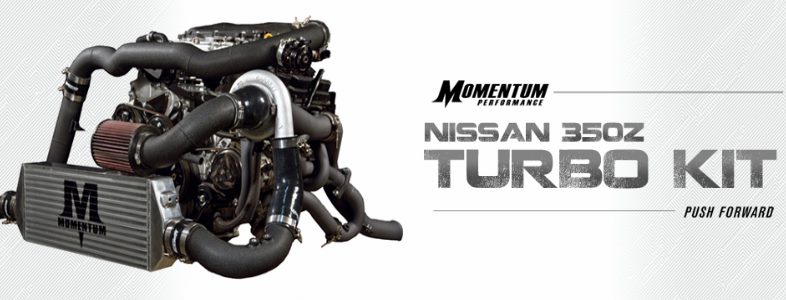$0.00
Industry Tech:
Single vs. Twin Turbos: The Timeless Debate
Written by our Friends at Momentum Performance
The twin turbo versus single turbo debate is one that is waged fiercely between the two different camps. Chances are at some point you’ve found yourself caught in the line of fire while passionate proponents of each side have slugged it out, argument-style over which one was better. Attitudes aside, taking a hard look at the technical details surrounding each of these types of turbo installations provides us with the data needed to make an educated decision about which is the most appealing option for drivers looking to make maximum power from their Nissan 350Z.
The ideas behind each are fairly basic. In a single turbo setup, only one turbocharger feeds air to the engine, while a twin turbo kit uses two turbochargers that are arranged either in parallel or in sequence. At first glance, it might seem like two turbochargers equals twice the power, but the reality is far from being that simple.
Twin turbo engines are in fact built not so much to generate startling peak power but rather to better manage lag and improve drivability. Since each turbo is driven by only half of the engine’s exhaust gas energy, smaller turbos are generally used in order to ensure that they spin up rapidly enough. In V-engine setups, a turbo is typically assigned to each bank of cylinders in a parallel configuration. Sequential setups go even further when it comes to reducing lag by using two different-sized turbos. The primary small turbocharger is meant to operate during the regular engine speeds that are typically encountered during normal driving situations, offering quick bursts of power with a relatively low peak. The small turbo can also serve as a method of ‘priming’ the larger, secondary turbo, allowing to spool up in advance of its use. At higher engine speeds, the secondary large turbo comes into play and adds a significantly greater amount of boost to the overall equation, in some cases even causing the primary turbo to be bypassed.
Parallel turbos are favored by OEM automakers due to the packaging benefits they offer. Having a turbo for each bank of cylinders dramatically reduces the complexity and length of piping required, and in the case of cars where space is limited under the hood this allows for an easier turbo implementation at the factory. Less plumbing can also lead to less lag. Sequential turbos are far more complicated to implement, and are not often found in stock vehicles, with a few notable exceptions from the 1990’s when manufacturers decided to throw reliability out the window and focus on over-engineering.
So far, all of the arguments in favor of a twin turbo setup have centered around two things: convenience and practicality. Yes, it’s nice to be able to save space in the engine bay and yes it’s great to minimize lag but these two design characteristics of a multi-turbo setup ultimately set you up for a big compromise on power. Simply put, most twin turbo setups on a Nissan 350Z do not offer the same potential for peak horsepower output provided by a large single turbo. If you want bragging rights, you need to leave the twin-training wheels behind and move up to the big leagues.
There are a number of technical reasons as to why a 350Z single turbo setup is capable of generating more impressive power than a twin turbo installation, but essentially it all boils down to airflow. As discussed above, most twin turbochargers are only driven by half of an engine’s exhaust gas energy. This necessitates that they be small enough in size to spool in a reasonable amount of time, which in turn creates a restriction on the volume of air that can flow through that turbocharger. While boost levels might be the same, airflow will be dramatically reduced.
Airflow is one of the most misunderstood aspects of turbo design. Anyone who has ever been to a drag strip has heard tuners brag about their boost levels without actually clueing in that these numbers are only part of the equation. It’s a common mistake to assume that identical boost levels from two different-sized turbochargers equals the same power output in a Nissan application. This could not be further from the truth. Producing maximum power from a turbocharger installation means maximizing the efficiency of the selected turbo to match the air flow that you need to make the power you seek. This reduces the amount of heat imparted by the turbocharger into the intake charge. Calculating the amount of airflow in cubic feet per minute (cfm) required by an engine can be done by using the following formula:
Pressure Ratio (turbo PSI / atmospheric pressure) x Engine Capacity in Cubic Feet x ½ of engine RPM x Volumetric efficiency (between 80 and 90% on most modern engines)
The smaller units used in a twin-turbo setup will not be able to remain efficient at higher airflow levels, and eventually their size will restrict peak performance. Examining a turbocharger’s turbine wheel illustrates this point further. The inner diameter or extruder bore of the turbine outlet determines the amount of airflow that can pass through the units, with a 2 inch diameter allowing between 250 and 400 cfm and a 3 inch diameter increasing that airflow capacity to 700 cfm or more.
The ratio between the cross-sectional area of a turbocharger’s turbine scroll and the radius from its edge to the center of the turbine wheel also plays a role in determining how much peak power a turbo can make. A larger ratio means that a greater amount exhaust gas energy can push against the wheel, in turn generating larger peak horsepower numbers.
Single turbo setups can make use of the larger turbochargers required to flow the larger amounts of air described above, thanks to their ability to concentrate all of the engine’s exhaust energy at once. This larger airflow translates into much higher power levels, and as a result at the drag strip or race track Nissan 350Zs with single turbos almost always dominate twin turbo setups. Twin turbochargers might be acceptable to those who are only looking to add a bit of extra grunt to their daily drivers, but for performance car enthusiasts looking to flirt with the edge of what their Nissan can offer them in terms of horsepower, a single turbo setup is clearly the best way to go.





